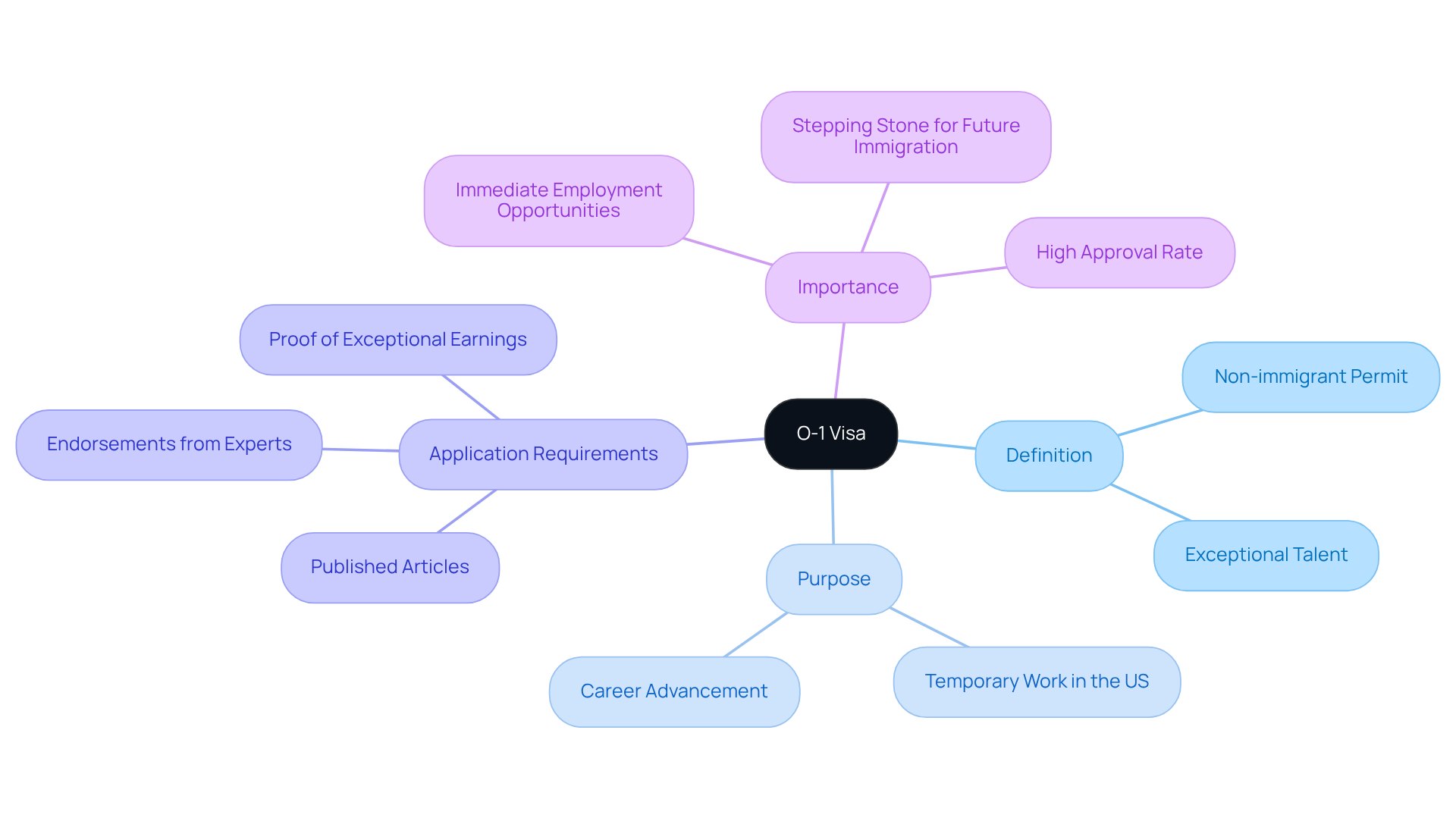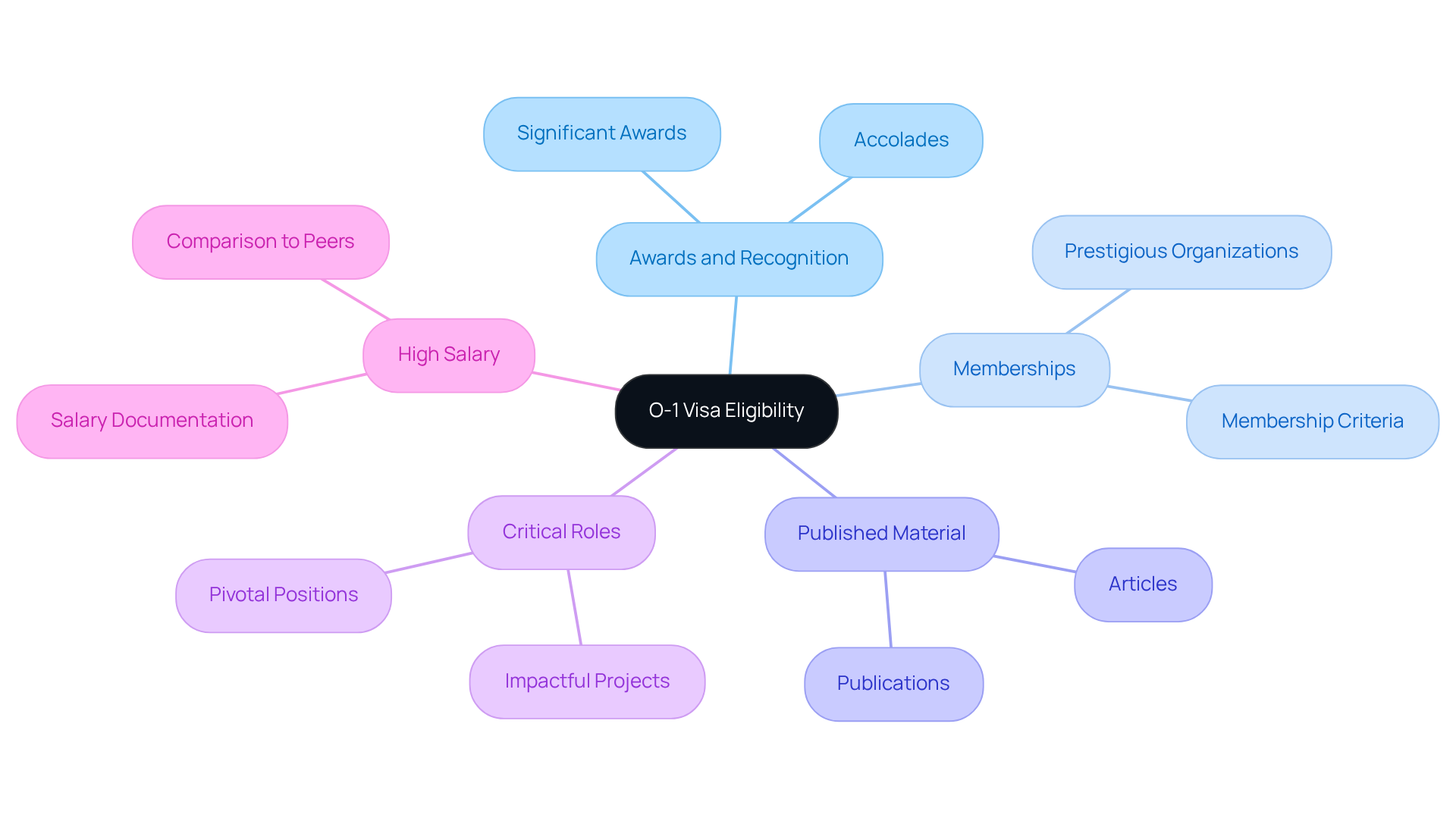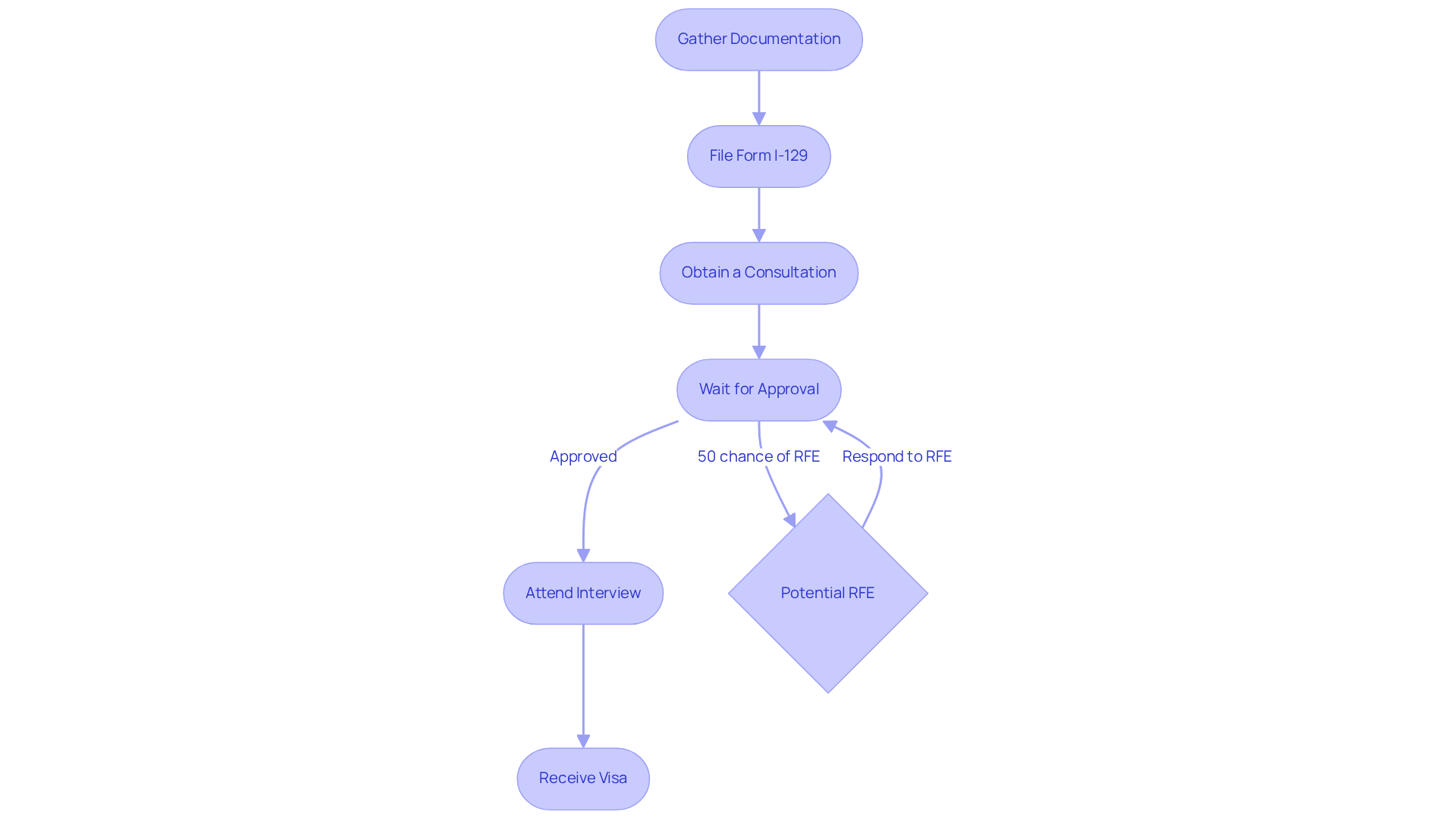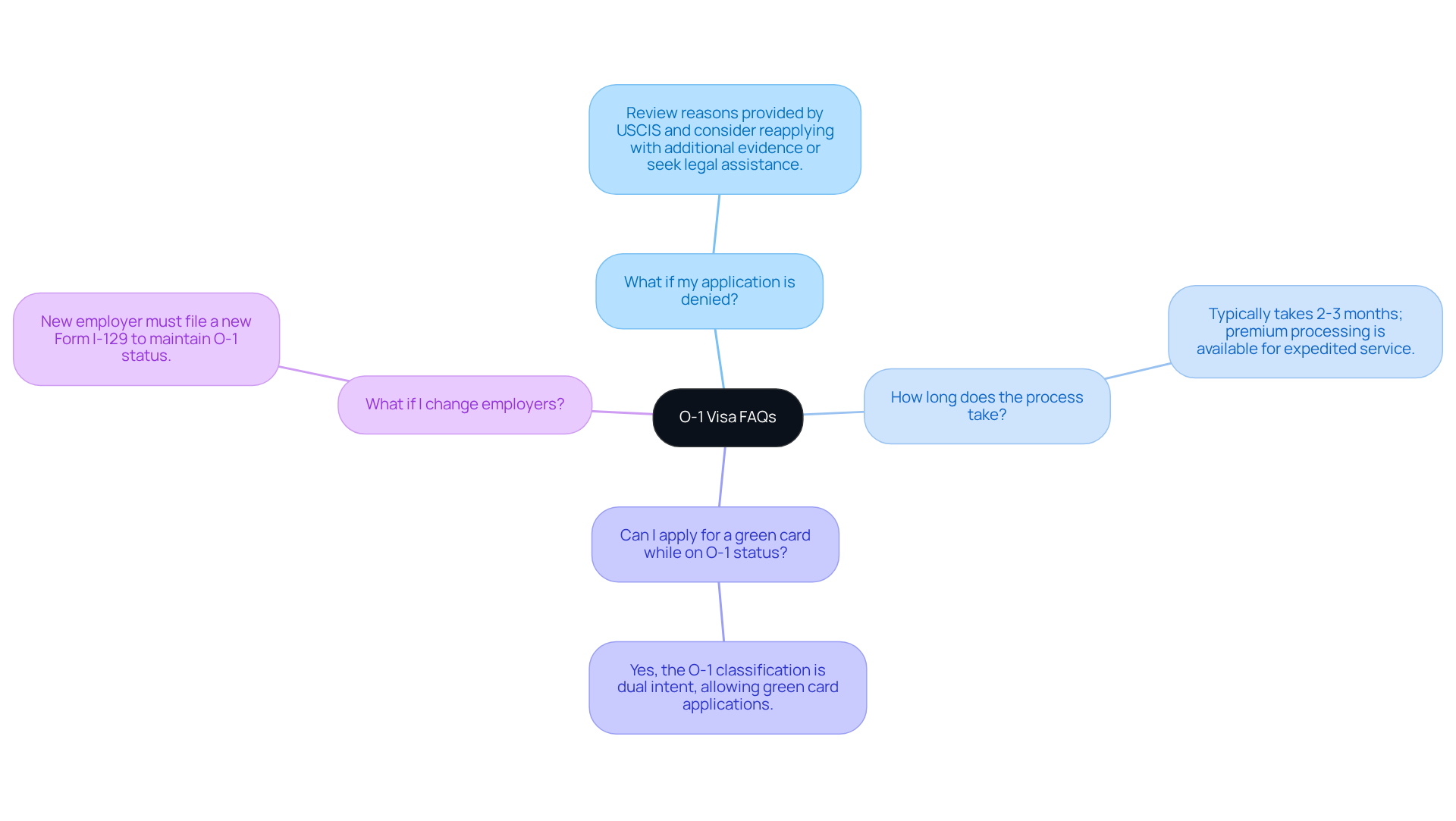Overview
This article serves as a comprehensive guide for immigrant workers seeking to master the O-1 visa application process. It highlights the critical need to showcase exceptional talent through substantial evidence. By outlining the step-by-step procedures required for a successful application, we aim to equip applicants with the knowledge they need to effectively navigate potential challenges. Remember, you’re not alone in this fight—we’re here to support you every step of the way.
Introduction
Navigating the complexities of the U.S. immigration system can feel overwhelming, especially for talented individuals seeking the O-1 visa. This specialized non-immigrant permit not only allows skilled professionals to work in the United States but also serves as a vital pathway for those looking to establish themselves in their fields.
As the number of O-1 visa petitions continues to rise, the stakes are higher than ever. How can prospective applicants ensure their success amidst shifting requirements and potential pitfalls? This guide provides a clear roadmap to mastering the O-1 visa process, empowering talented individuals to seize the opportunities that await them in the U.S.
Remember, you’re not alone in this fight—we’re here to support you every step of the way.
Understand the O-1 Visa: Definition and Purpose
The O-1 visa classification is a non-immigrant permit designed for individuals who demonstrate exceptional talent in fields such as the arts, sciences, education, business, or athletics. The O-1 visa enables talented workers to temporarily reside and work in the United States, making it a vital option for those looking to advance their careers.
Have you ever felt overwhelmed by the immigration process? In 2025, the number of O-1 visa petitions submitted reflects a growing recognition of its importance, especially among individuals who have achieved national or global acclaim.
Successful O-1 visa petitions often include compelling evidence of achievements, such as:
- Published articles
- Endorsements from experts
- Proof of exceptional earnings
The O-1 visa not only opens doors to immediate employment opportunities but also serves as a crucial stepping stone for future immigration pathways, highlighting its significance for those eager to make their mark in the U.S.
It’s important to know that a well-prepared application, backed by substantial evidence, greatly increases the chances of approval. We understand how daunting this process can be, but remember: the is an essential consideration for talented individuals seeking to secure their future. We’re here to fight for your family and support you every step of the way.

Determine Eligibility: Key Requirements for the O-1 Visa
To be eligible for the , candidates must convincingly demonstrate exceptional talent in their respective fields. This can be substantiated through various forms of evidence, including:
- Awards and Recognition: Documentation of significant awards or accolades that highlight your achievements in your field.
- Memberships: Proof of membership in prestigious organizations that require outstanding accomplishments for entry.
- Published Material: Articles or publications that showcase your work and contributions to the industry.
- Critical Roles: Evidence of having held pivotal positions in distinguished organizations or projects, underscoring your impact.
- High Salary: Documentation indicating that you earn a salary significantly higher than others in your field, which can serve as a strong indicator of your expertise. In fact, a significant portion of O-1 Visa applicants report high salaries, which further validates their assertions of exceptional ability.
Collecting significant evidence to support claims of exceptional ability is essential for the success of your O-1 visa application, as this documentation serves an important function. The revised guidelines for 2025 highlight the significance of thorough preparation and precise documentation, making it essential to present a compelling case for your exceptional abilities. As mentioned by Panteva Law Group, 'The revised USCIS guidance on the O-1 visa is a positive move toward making the O-1 visa for exceptional ability more accessible and transparent.' Furthermore, O-1 visa holders may have the opportunity to transition to green cards, including the remarkable ability green card (EB-1A), which provides a pathway to permanent residency.

Navigate the Application Process: Step-by-Step Instructions
Navigating the application process for the O-1 Visa can be daunting, but understanding the key steps will empower you to take action with confidence:
- Gather Documentation: Start by collecting essential documents that showcase your exceptional ability—think major awards, significant publications, and letters of recommendation from recognized experts in your field. Remember, you need to meet at least three out of the eight standards for exceptional talent to strengthen your submission.
- File Form I-129: Next, submit Form I-129, Petition for a Nonimmigrant Worker, along with the standard filing fee of $6,000. If you want to expedite the process, consider the optional premium processing fee of $2,805. Make sure your submission is complete; even small errors can lead to frustrating delays or denials.
- Obtain a Consultation: If applicable, secure a written advisory opinion from a peer group or labor organization in your field. This letter serves as a crucial endorsement of your remarkable skill and can significantly enhance your submission.
- Wait for Approval: After you submit your application, USCIS will process it, typically taking two to three months. During this period, be prepared for the possibility of a Request for Evidence (RFE)—last year, about 50% of applications encountered this hurdle. This statistic underscores the importance of to avoid such requests. Responding promptly to any RFEs is vital to prevent unnecessary delays.
- Attend Interview: If your petition is approved, the next step is to schedule an appointment at a U.S. consulate or embassy in your home country. Bring all required documentation, including your employment contract and proof of your extraordinary ability.
- Receive Visa: Once you successfully complete the interview, you will receive your O-1 Visa, paving the way for your move to the U.S.
Each step is critical, and your attention to detail is essential for a smooth application process. Remember, you will need support from a U.S. employer or representative, as you cannot apply on your own. If your petition is denied, don’t lose hope—you can appeal the decision or reapply with additional evidence. We’re here to fight for your family and ensure your future matters.

Address Common Challenges: FAQs and Troubleshooting Tips
Here are some frequently asked questions and troubleshooting tips for O-1 Visa applicants:
- What if my application is denied?: If your application is denied, take a moment to review the reasons provided by USCIS. Consider reapplying with additional evidence or seek legal assistance to strengthen your case.
- How long does the process take?: The processing time can vary, but it typically takes 2-3 months. If you need it faster, premium processing is available for expedited service.
- Can I apply for a green card while on O-1 status?: Yes, the O-1 classification is dual intent, allowing you to apply for a green card while maintaining your O-1 status.
- What if I change employers?: If you change employers, it’s crucial that your new employer files a new Form I-129 to maintain your O-1 status.
At Vasquez Law Firm, we understand that navigating the O-1 application process can be overwhelming, especially when financial issues arise. That’s why we offer with no upfront costs for personal injury cases, ensuring that you can seek the justice you deserve without financial constraints. For other legal needs, we provide flexible payment plans tailored to your situation. By being aware of these common challenges and knowing how to address them, you can navigate the O-1 Visa process more effectively, with the assurance that financial support is available to assist you in securing your O-1 Visa. Remember, you’re not alone in this fight—we’re here for you.

Conclusion
Mastering the O-1 visa process is crucial for immigrant workers eager to showcase their exceptional talents in the United States. This non-immigrant visa not only opens doors to immediate employment opportunities but also lays the groundwork for future immigration possibilities. Understanding the nuances of the application process, eligibility criteria, and the necessity of thorough documentation is vital for a successful petition.
Throughout this article, we’ve discussed key elements such as:
- The definition and purpose of the O-1 visa
- Detailed eligibility requirements
- A step-by-step guide to navigating the application process
The importance of gathering compelling evidence to demonstrate exceptional ability cannot be overstated; it plays a pivotal role in securing visa approval. Furthermore, addressing common challenges and offering practical troubleshooting tips equips applicants with the knowledge needed to overcome potential hurdles.
Ultimately, the O-1 visa represents a valuable opportunity for talented individuals seeking to make their mark in the U.S. By being well-prepared and informed about the application process, candidates can significantly enhance their chances of success. For those considering the O-1 visa, taking proactive steps and seeking guidance can lead to a fruitful career in the United States, paving the way for a promising future. Remember, we’re here to fight for your family and your future matters to us.
Frequently Asked Questions
What is the O-1 visa?
The O-1 visa is a non-immigrant permit for individuals who demonstrate exceptional talent in fields such as the arts, sciences, education, business, or athletics, allowing them to temporarily reside and work in the United States.
Who is eligible for the O-1 visa?
The O-1 visa is designed for individuals who have achieved national or global acclaim in their respective fields and can provide compelling evidence of their exceptional talent.
What kind of evidence is required for a successful O-1 visa petition?
Successful O-1 visa petitions often include evidence such as published articles, endorsements from experts, and proof of exceptional earnings.
What are the benefits of obtaining an O-1 visa?
The O-1 visa opens doors to immediate employment opportunities in the U.S. and serves as a crucial stepping stone for future immigration pathways.
How can one increase the chances of O-1 visa approval?
A well-prepared application backed by substantial evidence greatly increases the chances of approval for the O-1 visa.
Why is the O-1 visa important for talented individuals?
The O-1 visa is essential for talented individuals seeking to secure their future in the U.S. by allowing them to work and advance their careers in their fields of expertise.




